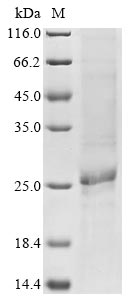This recombinant HumanRNF5 protein is an in vitro E.coli (cell-free) expressed protein (Full Length of Mature Protein). Its purity is 85%+ determined by SDS-PAGE. Cell-free protein expression is the in vitro synthesis of a protein using translation-compatible extracts of whole cells. In principle, whole-cell extracts contain all the macromolecules and components needed for transcription, translation, and even post-translational modification. These components include RNA polymerase, regulatory protein factors, transcription factors, ribosomes, and tRNA. When supplemented with cofactors, nucleotides, and the specific gene template, these extracts can synthesize proteins of interest in a few hours.
RNF5 is an endoplasmic reticulum (ER)-related E3 ubiquitin ligase that constitutes the UBC6e-p97 complex, which is involved in ER-associated degradation (ERAD). RNF5 can recognize misfolded proteins and facilitate their ubiquitination and proteasomal degradation. It is involved in the inflammatory response in viral infections through the ubiquitination of transmembrane protein 173 as well as suppression of the activation of virus-induced interferon regulatory factor 3, expression of interferon beta 1, and the cellular antiviral response. RNF5 is upregulated in several cancers, including breast cancer, hepatocellular carcinoma, and acute myeloid leukemia (AML). Inhibition of RNF5 expression reduces proliferation of breast cancer cells.






